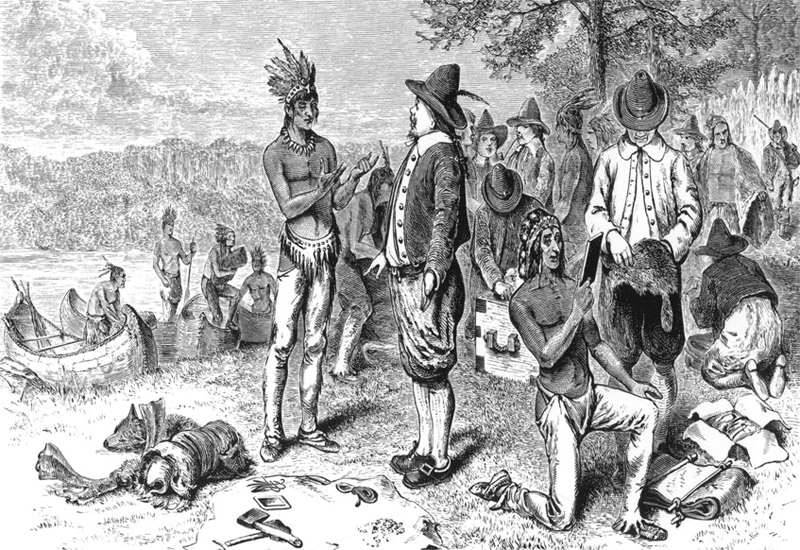
Dutch merchants, like these bargaining with Native Americans on Manhattan Island in the early 1600s, turned Holland into the greatest trading empire of the seventeenth century. (© North Wind Picture Archives)
The official language of the Netherlands, the Flemish part of Belgium, the Dutch Antilles, and the Republic of Suriname, and also refers to the people and culture of the Netherlands.
The Dutch language belongs to the West Germanic group of Indo-European languages and is used by more than 20 million people. According to the description of the eighteenth-century novelist Daniel Defoe, the Dutch were “the Carryers of the World, the middle Persons in Trade, the Factors and Brokers of Europe.” This description of the Dutch was no coincidence. Historically, the Dutch republic and society between the fifteenth and the nineteenth centuries fascinated the contemporary merchants, scholars, sailors, and other visitors from different walks of life. These visitors of the Dutch republic were especially impressed by the capabilities of the Dutch in shipping, commerce, industry, finance, intellectual toleration, and the Dutch culture. The economic success of the Dutch constituted an example for other societies of the time, especially the Dutch methods of commerce and finance.
From the end of sixteenth century until the first half of the eighteenth century, the Dutch had supremacy in world trade and the Dutch republic was the central place of trade in commodities originating from all parts of the world. Maritime trade also had an impact on science: the maps of Willem Blaeu became a standard for mapmakers for centuries, and Hugo Grotius made the basic laws of the sea, which are still the basis for present-day laws. The Dutch were also advanced in technology—such as the use of windmills not only to drain parts of the country below the sea level, but also to provide power for basic industries—in the humanities with people like Desiderius Erasmus, and in art like Rembrandt.

Dutch merchants, like these bargaining with Native Americans on Manhattan Island in the early 1600s, turned Holland into the greatest trading empire of the seventeenth century. (© North Wind Picture Archives)
During its history, the Dutch “Seaborne empire,” as it became known, had trading stations and settlements in South America, like Brazil, North America, like New Amsterdam, which later became New York, and along the west coast of Africa, where a number of fortifications still exist. The main area, however, was the East Indies, where they governed present-day Indonesia, part of New Guinea, Sri Lanka, and Decima, an island in Japan. After World War II, the East Indies became independent in 1949 and are now the Republic of Indonesia.
The influence of the cultures in these foreign areas is still present in the Netherlands. The Dutch like Indonesian food and many people originating from that archipelago and other areas now live in the Netherlands. In the past decades, other nationalities have arrived in the Netherlands as well, such as Turkish immigrant workers or refugees from civil wars and oppression in faraway countries. The tolerance and support for these latter nationalities is still a source of pride to many Dutch. In recent times, the Dutch economy went through a period of strong growth, which was the result of the close cooperation between the labor unions and employer organizations. This became known as the “Polder Model,” referring to the “polder,” which are the areas of land drained during the seventeenth century. This illustrates the continuity of the Dutch: water, trade, and tolerance.
Esra LaGro
See also: Amsterdam.
Israel, Jonathan. The Dutch Republic: Its Rise, Greatness, and Fall. Oxford: Clarendon, 1995.